 
Some Product Improvements
As consumers have started to demand environmentally improved products, more and more of the companies that sell to them are responding. And they are discovering benefits to their bottom line: consumers, manufacturers, and the environment all win when accurate and truthful environmental claims are used to draw consumers' attention to improved products.
Here are several recent examples .
Goodbye to the Clamshell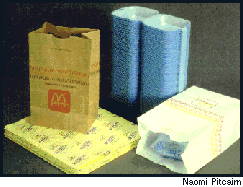
Shown here are two of the more visible packaging changes made by McDonald's Corporation in the course of the company's work with EDF. By replacing its polystyrene foam clamshells with thin paper wraps, McDonald's reduced the volume of sandwich packaging headed to landfills and incinerators by almost 80%--And saved on the costs of packaging, storage, transportation, and disposal to boot!
McDonald's was pleasantly surprised by the overwhelming positive reaction from its customers when it brought back the brown bag. But this one is not only unbleached, it's made of 100% recycled paper.
Less Packaging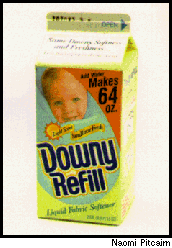
Sometimes, reviving an old idea makes sense--and cents. Procter & Gamble earned kudos from consumers with this new hot-seller: The Downy® Refill. Like frozen orange juice, it's a concentrate that is designed to be diluted with water into a larger container used in the laundry room. And it's easier to tote home from the supermarket. Procter & Gamble reduced its packaging and transportation costs, and best of all, the new package means less packaging waste. In this case, Procter & Gamble's environmental claim was truthful, not the overstatement it used with its disposable diapers. It reads simply: "Less packaging to throw away."
Closing the Loop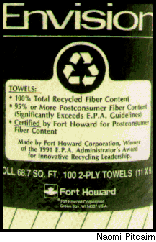
More and more companies are finding that investing in the technology needed to make environmentally improved products pays off in a number of ways.The Fort Howard Corp. uses more than a million tons of recovered paper to make tissue products at three highly profitable paper mills. In the past, producers of recycled paper sometimes shied away from telling consumers how their products were made. In response to consumer demand, however, Fort Howard not only began advertising its product as recyclable, but reformulated its "Envision" line of paper towels to maximize its post-consumer recycled content.
The company's long-standing commitment to using recycled materials in manufacturing its products earned it a 1991 Administrator's award from the U.S. Environmental Protection Agency, for its leadership in helping to "close the recycling loop." The recycling loop starts with the collection of discarded materials, but doesn't come full circle unless those materials are used in making new products and those products are purchased by consumers.
Improving the Bottom Line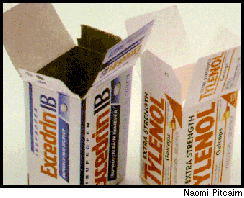
These two boxes for pain relievers made by different companies look very similar from the outside and carry out the functions they serve equally well. But notice the subtle difference that can be seen when looking from the inside out: the box with the grey interior is made from 100% recycled paperboard, while the other is made from bleached virgin paperboard. And the recycled box costs less!
As major over-the-counter pharmaceutical companies switch to recycled packaging, a new market is created for recycling old newspapers, office paper, and more. And as this example shows, in case after case, manufacturers are finding that using materials that create fewer environmental impacts need not cost more or compromise the function or appearance of a product or its package.
Hold the Bleach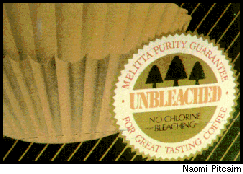
A newer category of environmental claim, not yet well-understood by consumers, has begun to appear on specialty paper products, such as the coffee filters shown here, that were produced without using chlorine to bleach the paper bright white. Chlorine bleaching of paper is a major source of water pollution from paper mills; by using more benign bleaching agents--or better yet, not bleaching at all when, as in this case, there's no need for the product to be bright white--makers of paper products can greatly reduce their impact on the environment. And discerning consumers can make a real difference by "voting for the environment" with their purchasing dollars.
|








